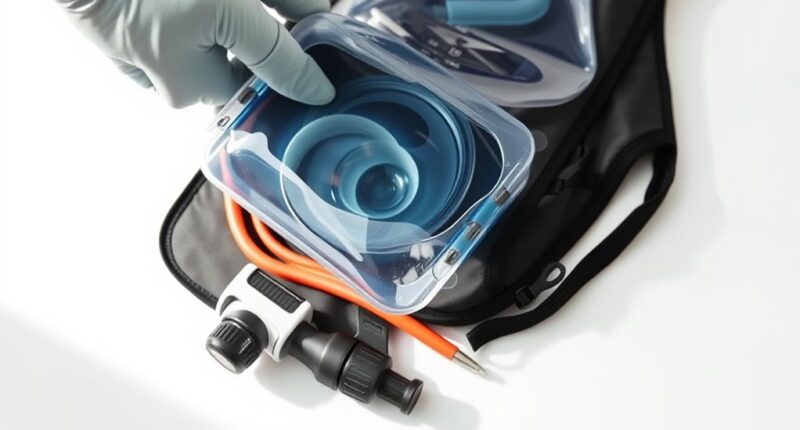To quickly deep-clean your hydration pack in 20 minutes, start by gathering brushes, microfiber towels, and warm soapy water, then set up a clean workspace. Empty and rinse the reservoir and hoses thoroughly, scrubbing all parts with a mild soap. Next, disinfect with a vinegar solution and rinse well. Finally, dry all components completely before storing in a cool, dry place, with the cap off. If you keep going, you’ll discover tips to keep it fresh longer.
Key Takeaways
- Empty and disconnect hoses, then rinse with clean water to remove residual fluids and debris.
- Use a mild soap solution to scrub all surfaces, including hoses and caps, ensuring thorough cleaning.
- Disinfect the reservoir with a vinegar-water mix, letting it sit for 15–20 minutes before rinsing thoroughly.
- Dry all parts completely by hanging or using a fan to prevent mold and odors.
- Store the hydration pack in a cool, dry place with the cap off for proper ventilation and longevity.
Gather Your Supplies and Prepare Your Workspace
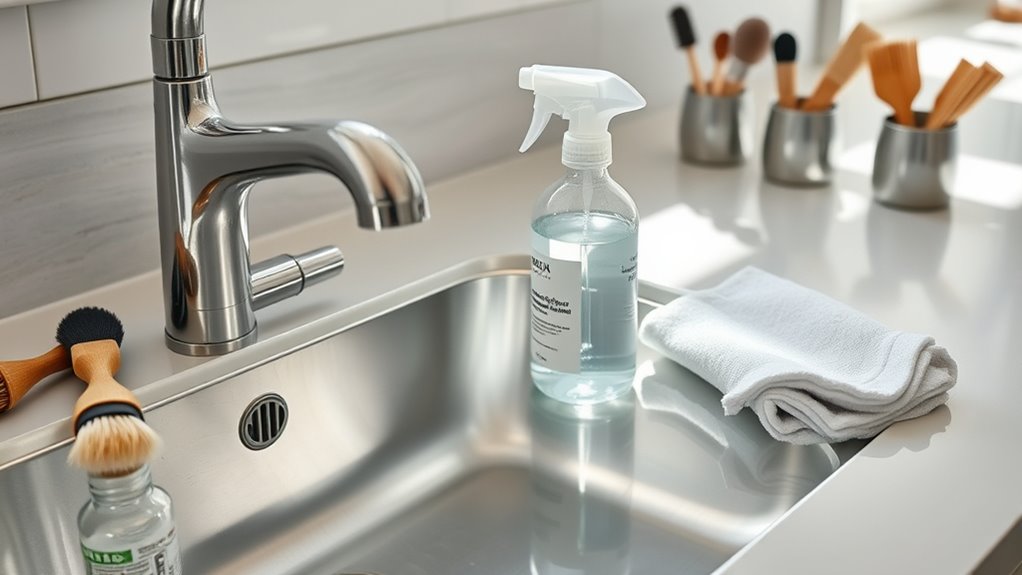
Before you begin cleaning your hydration pack, gather all the necessary supplies and set up a clean, organized workspace. You’ll need cleaning brushes designed for bottles and reservoirs to scrub away residue effectively. Having a few microfiber towels or clean cloths on hand makes drying and wiping easier. Prepare a basin or sink with warm water and mild soap for rinsing. Consider storage tips, like keeping your hydration pack in a cool, dry place between uses, to prevent mold and odors. Keep your brushes nearby for easy access during cleaning. By organizing your supplies beforehand, you’ll streamline the process and ensure you don’t forget any essential tools. A tidy workspace helps you clean thoroughly and efficiently, saving you time and effort later.
Empty and Rinse the Reservoir and Hoses
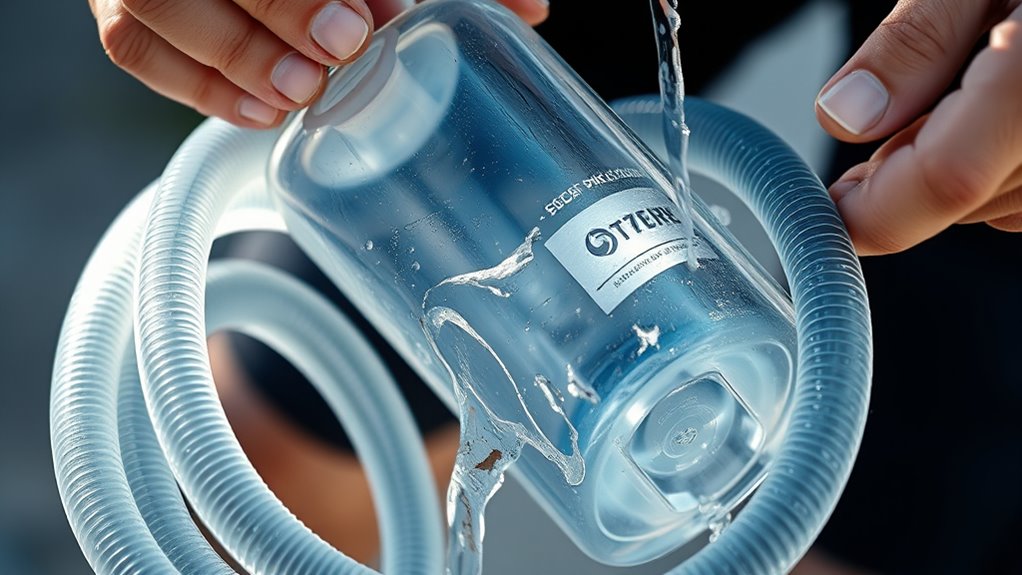
To start, completely empty the reservoir and disconnect the hoses to remove any remaining water or residue. This step prevents mold buildup and guarantees thorough cleaning. Be mindful of your reservoir material; some plastics are more prone to cracking if not handled carefully. Rinsing the reservoir and hoses with clean water, making sure to flush out all traces of previous fluids, is essential for proper hygiene. The hoses’ flexibility allows you to bend and shake out stubborn debris or buildup. Incorporating proper water conservation techniques in your cleaning process can help ensure that no residues affect future use. Additionally, using appropriate cleaning solutions can effectively disinfect without damaging the materials. Use the table below to understand different reservoir materials and hose considerations:
| Reservoir Material | Hose Flexibility | Cleaning Tip |
|---|---|---|
| Plastic | Very flexible | Avoid excessive bending |
| Nylon | Moderate | Shake to dislodge debris |
| Rubber | Flexible | Inspect for cracks |
| Polycarbonate | Rigid | Handle gently |
Clean the Reservoir and Components With a Soapy Solution
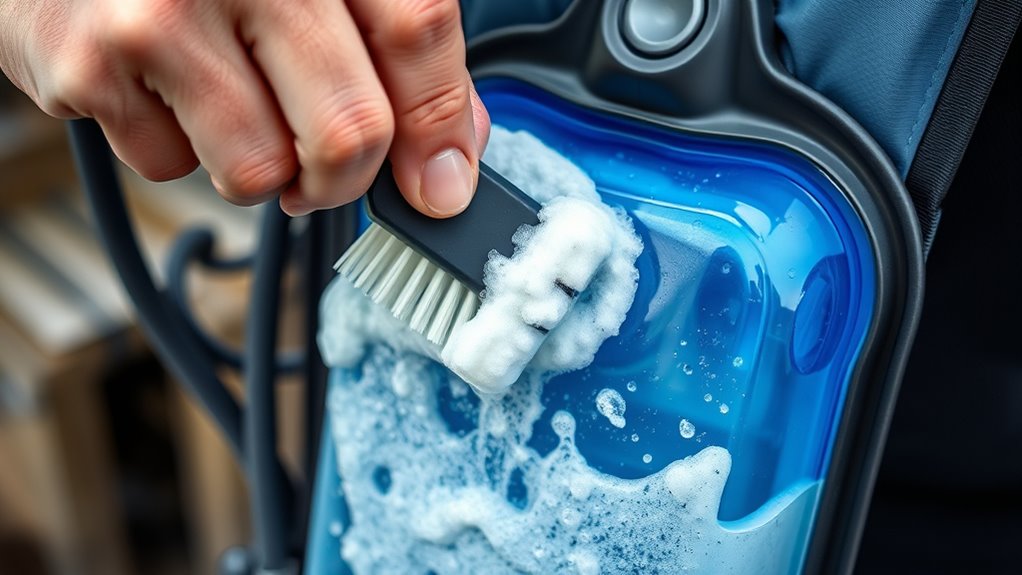
Applying a soapy solution is essential for thoroughly cleaning your reservoir and its components. Start by choosing a mild soap that suits your reservoir material, whether plastic, silicone, or another material. Fill your reservoir with warm water and add a few drops of dish soap, then use a brush or sponge to scrub all surfaces, including hoses and caps. This step helps remove dirt, bacteria, and residues that can build up over time. Remember, cleaning frequency depends on your usage; if you use your hydration pack daily, aim to clean it at least once a week. Regular cleaning prevents mold and unpleasant odors, ensuring your hydration system remains safe and functional during every adventure. Additionally, using a glycolic acid-based cleaner can help exfoliate dead skin cells and other residues, reducing buildup and maintaining a fresh environment inside your reservoir. Proper maintenance practices are crucial for extending the lifespan of your hydration pack and ensuring optimal performance. Incorporating antimicrobial solutions can further inhibit bacterial growth, keeping your hydration system cleaner for longer periods.
Disinfect and Remove Odors With a Vinegar Solution
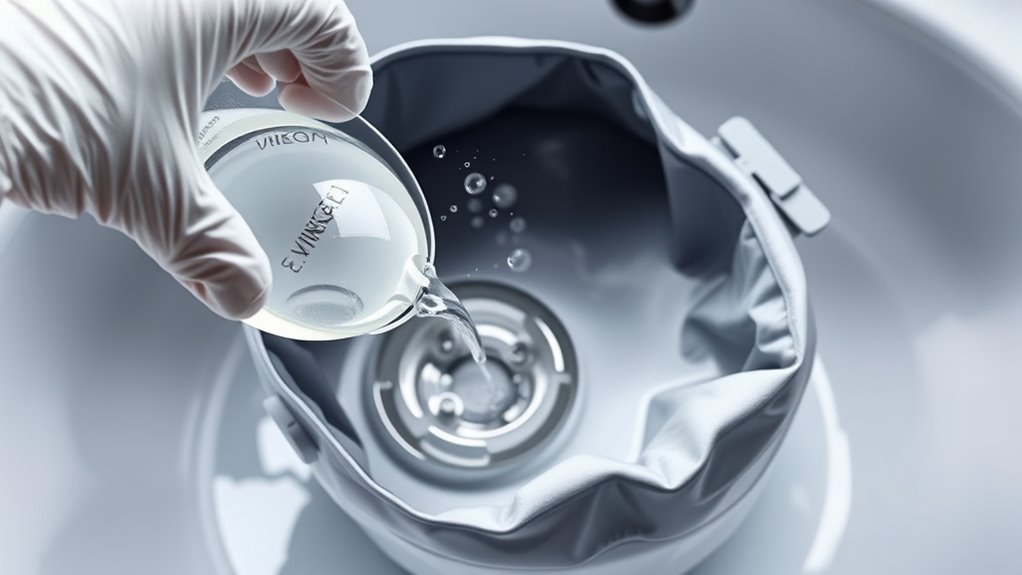
Vinegar is a natural disinfectant that effectively kills bacteria and mold, making it ideal for deodorizing your hydration pack. To use it, prepare a vinegar solution by mixing equal parts white vinegar and water. This solution not only disinfects but also helps with odor removal. Here’s how to do it:
- Fill your hydration reservoir with the vinegar solution.
- Let it sit for 15–20 minutes to disinfect and neutralize odors.
- Rinse thoroughly with clean water to remove any residual vinegar taste.
- Incorporating this hygiene routine regularly helps maintain the gear’s longevity and safety of your gear.
This simple process guarantees your hydration pack stays fresh, clean, and odor-free. Regular use of a vinegar solution keeps bacteria at bay and maintains the overall hygiene of your gear.
Dry and Store Your Hydration Pack Properly
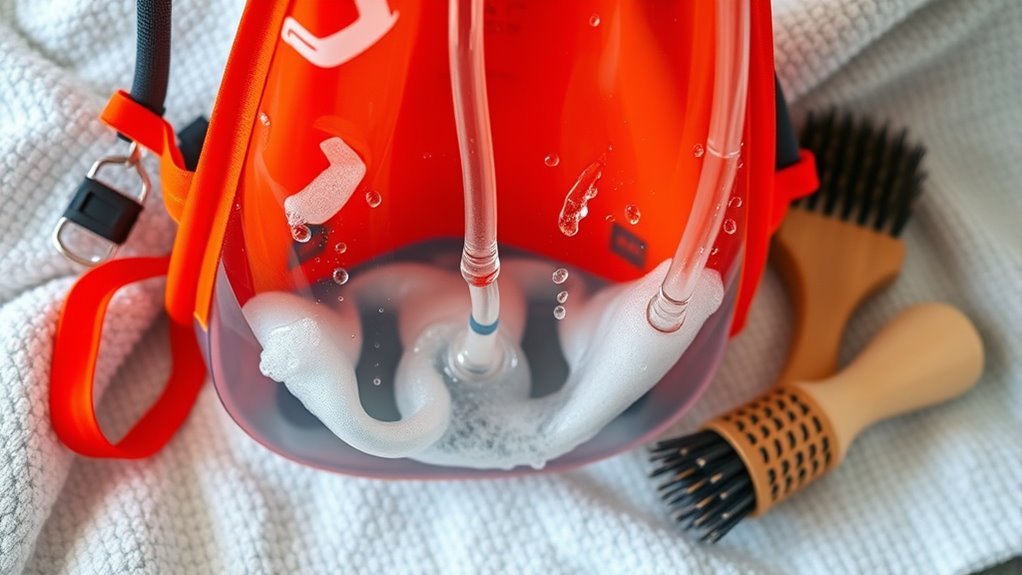
After cleaning your hydration pack, make sure it’s completely dry before storing it to prevent mold and bacterial growth. Proper storage tips include keeping your pack in a cool, dry place away from direct sunlight. Use effective drying techniques, such as hanging the pack upside down with the nozzle open or using a fan to promote airflow. Ensure all parts, especially the reservoir and hose, are thoroughly dried to avoid moisture buildup. If possible, store your hydration pack with the cap off to improve ventilation. Avoid leaving it in humid environments or sealed containers, which can trap moisture. Being aware of hydration pack weight can help you handle and store your equipment more safely. Following these drying techniques and storage tips will help maintain your hydration pack’s hygiene and extend its lifespan.
Frequently Asked Questions
How Often Should I Deep-Clean My Hydration Pack?
You should deep-clean your hydration pack after every 3 to 4 uses or if you notice any odors or mold. Regular cleaning helps prevent bacteria buildup and keeps your pack fresh. To maintain it, follow proper storage tips like keeping it dry and in a cool place. This cleaning frequency guarantees your pack stays hygienic and ready for your next adventure, making sure you stay healthy and comfortable on every trip.
Can I Use Bleach to Disinfect My Hydration Pack?
Think of your hydration pack as a trusted ally on your adventures. Using bleach for disinfection safety isn’t recommended, as it can damage materials and leave harmful residues. Instead, opt for safe disinfection methods like diluted white vinegar or specialized cleaning solutions. These gentle yet effective options keep your pack clean without risking deterioration, ensuring your hydration partner stays fresh and ready for every journey.
What Are Signs My Hydration Pack Needs a Deep Clean?
If you notice a foul smell, cloudy water, or mold growth, your hydration pack needs a deep clean. These are clear signs of contamination and indicate poor hydration pack maintenance. Don’t ignore these symptoms, as they can lead to health issues. Regular cleaning prevents buildup and keeps your pack fresh. When you see these signs, it’s time for a thorough cleaning to guarantee safe, clean hydration on your adventures.
Is It Safe to Use Hot Water During Cleaning?
Ever wonder if hot water is safe for cleaning your hydration pack? It might seem like a quick fix, but water temperature can impact cleaning safety. Hot water can help kill bacteria, but if it’s too hot, it could damage the materials or cause warping. Stick to warm or lukewarm water for safe, effective cleaning. Always check your pack’s manufacturer instructions to avoid any damage and ensure cleanliness.
How Do I Prevent Mold and Mildew Buildup?
To prevent mold and mildew buildup, you should regularly clean your hydration pack, focusing on scent prevention. Use a solution that’s compatible with your pack’s material to avoid damage. After cleaning, thoroughly dry all parts and store your pack in a cool, ventilated area. Avoid leaving moisture inside, and consider using odor-neutralizing tablets or sprays to keep your pack fresh and mold-free over time.
Conclusion
Now that you’ve deep-cleaned your hydration pack in just 20 minutes, it’s ready for its next adventure. But remember, the secret to lasting freshness lies in regular upkeep—miss a step, and unseen residues could linger. Will your pack stay pristine through your next hike, or will hidden odors surprise you? Stay vigilant, and your hydration gear will serve you reliably, whispering promises of fresh, clean sips every time you reach for it.
